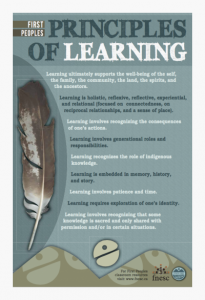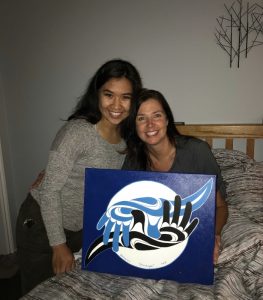
“Storytelling – The One Eyed Evil” by London Permaculture is licensed under CC BY-NC-SA 2.0
Earlier this week we read two very different papers on decolonization written by Dr. Shauneen Pete, and had the privilege of meeting Dr. Pete in our EDCI 515 class. The first reading, Idle No More, left me frustrated and agitated. I wondered if my reaction was simply a mirror of the spirit in which the chapter was written (as Dr. Pete was transparent in her writing regarding her frustration with teaching pre-service white teachers). My demeanor changed drastically when I started reading Meschachakanis, A Coyote Narrative: Decolonising Higher Education. It was brilliantly written and thought provoking, and displayed the powerful impact that storytelling can have on the reader. Dr. Pete explored decolonising practices in higher education through storytelling, and it prompted me to consider the role of storytelling in the science curriculum.
In this blog I will
- review why indigenous knowledge is required content in the BC Curriculum
- explore the validity of storytelling in science
- Consider the role that storytelling had in my response to the readings by Dr. Shauneen Pete and how that relates to storytelling in science
- provide resources to further investigate the role of storytelling in science
Why is indigenous knowledge required in BC Curriculum?
The New BC Science Curriculum requires
that the voice of Aboriginal people be heard in all aspects of the education system; the presence of Aboriginal languages, cultures, and histories be increased in provincial curricula; and leadership and informed practice be provided.
Why is it imperative that our education system respond to the Summary of the Final Report of the Truth and Reconciliation Commision of Canada? A thorough answer to this question might recount details of BC Human Rights, The Indian Act (original and revised), Bill C-31, residential schools, and countless other references and historical events, however I would like to respond by highlighting a few statistics involving BC Indigenous students (as presented in January 2019 during a series of workshops on Indigenous education in science).
- Aboriginal students who self-identify make up 8% of SD61 student population
- Aboriginal students represent 30% of those in Behaviour Support Programs
- Aboriginal students make up about 2% of those taking senior science and math classes in GVSD high schools
- 6 year completion rate for Aboriginal students is 59% (provincial is 69%)
- 6 year completion rate for Aboriginal students living on-reserve is 40% (provincial is 57%)
As educators, we have many resources to draw upon when responding to the call to action. First Peoples Principles of Learning provides a valuable lens for teacher teams when drafting curricula.

Below I have noted some thought provoking videos for teachers new to the discussion of reconciliation, or videos that can be used for initiating conversations of reconciliation with learners:
8th Fire – 500 Years in 2 minutes
Murray Sinclair – What is Reconciliation (3 min)
Reconciliation Through Indigenous Education (2 min)
How to Talk About Indigenous People (2.5 min)
Martin Brokenleg video (9 min)
Martin Brokenleg’s video opens with the statement that First Peoples learning is embedded in memory, history and story. It might follow that storytelling is a crucial method for learning indigenous scientific knowledge.
An exploration into the validity of storytelling in science
The oral tradition of story telling is responsible for transferring knowledge in Indigenous culture. Gloria Snively & Wagnosts’a7 Lorna Williams spent 40 years writing the book Knowing Home: Braiding Indigenous Science with Western Science. Chapter 14 is titled “Storytelling is our Textbook and Curriculum Guide” and it explains the importance of storytelling to the Kwakwaka’wakw people. Stories provide rules, regulations and life lessons, they reveal interconnections with nature, and build upon the understanding that the land is the foundation of their teachings. Stories provide the wisdom of respecting all things and the value of community and working together. The authors take the reader through 8 ecology lessons that progress from spring science in March to salmon release in June.
In this unit of study the lessons explored how the Kwakwaka’wakw made their living in the natural world. Students experienced and explored the exact territories that their ancestors walked. They were exposed to the beauty of the territories and the stories that were imbedded in nature. There were stories about the trees, mountains, lakes, rivers, rocks, birds, and fish.
In the article Indigenous Storytelling as Research Judy Iseke conducts interviews with Metis elders and discusses storytelling as a pedagogical tool. Iseke concludes that
Indigenous storytelling pedagogies encourage broader understandings of identity, community, culture, and relations. (pg 573)
When it comes to analyzing methodology of Traditional Western Science and Indigenous Knowledge Systems I appreciate the views of Gilbert Onwu in Indigenous knowledge systems and science and technology education: A dialogue:
I don’t think we should be looking at IKS with the same lens of judgment as we would do with Western science”.
He goes on to defend that each system requires different forms of verification, and that by not doing so we would be compromising one system at the expense of the other “and in the process lose the beauty of what the two systems could provide alongside each other.” (pg 6) What a wonderful concept. That each system has its own value, and that they each fill a void of knowledge present in the alternate approach. The scientist can reach a more thorough understanding by considering Traditional Western Science and Indigenous Knowledge together, rather than if only one of the systems were employed.
With this in mind, how can I apply the 4 R’s to the oral tradition of indigenous peoples? Is it appropriate to do so? In an attempt to understand storytelling in comparison to other qualitative research methods it can be an interesting exercise. The researcher includes generations of indigenous people that have passed their knowledge and wisdom on for the benefit of their community and future generations. Storytelling as research reveals intricate connections between self, community and the land that expand well beyond a single lesson, focus or discipline. The researched includes information passed on through many generations that is specific to the community and culture of the listener. Lastly, I am honoured to be invited to participate in the research of storytelling as the reader (or more, the listener), as the wisdom captured by storytelling can also benefit learners of non indigenous decent. Yes, it is interesting to consider storytelling through the lens of these four R’s, however I am reminded of The Five R’s for Indigenizing Online Learning: A Case Study of the First Nations Schools’ Principals Course and the five R’s (respect, relevance, reciprocity, responsibility, and relationships) seem to be a more appropriate approach when analyzing storytelling.
There are additional significant differences between the systems of Traditional Western Knowledge and Indigenous Knowledge. Co-author of Indigenous knowledge systems and science and technology education, Mogege Mosimege, brings up the point that
questioning is a critical component that seems not to be dominant in IKS and I think it is true that this does not help developments in IKS to advance beyond where they are. (pg 8)
Another stumbling block for IKS (when compared to traditional knowledge) is the reproducibility of the science. Without written documentation verifying knowledge gained through IKS is difficult. It seems to be a delicate balance between respecting each system for the qualities they possess, and suggesting alterations that might enhance credibility, validity, or rigor. In Canada, with relationships between settlers and indigenous people being delicate as we work towards reconciliation, it might be wise to leave the future of IKS to indigenous peoples and respect their knowledge systems for the unique contributions they provide. I hesitate as a settler to impose any more of my colonial ways on indigenous people, and instead I propose that we (white people) recognize and admit to the limitations of Traditional Western Science and practice respect and gratitude for the unique contributions of storytelling.

Conclusion
A significant difference between the two readings by Dr. Shauneen Pete was that of storytelling. When storytelling was used to discuss decolonization of higher education I was more open to listening and learning as I was invited into relationship with the author. Storytelling allows the listener to relate the stories to their own lives, make connections and draw new meanings. It includes cultural context that can otherwise be overlooked and reveals new perspectives that expand our understandings. When we compare Indigenous Knowledge Systems of storytelling to Traditional Western Science we might conclude that one fills a void in the other and vice versa. Through storytelling the author invites the learner into a deeper understanding of the natural world that nurtures relationship and connectedness. I am grateful to Dr. Pete for sharing her stories with us, and reminding me of the importance of relationships and connections when it comes to living, learning and teaching.
Resources to Further Investigate the Role of Storytelling in Science
Additional resources for First Nations Education in Science are available from
- the First Nations Education Steering Committee at fnesc.ca
- Truth and Reconciliation Commission: Calls to Action
- the Ministry of Education Report on Actions Taken to Support Truth and Reconciliation
- STEM Curriculum – Storytelling for Teaching Science, Technology, Engineering and Math by Jo Tomalin
- Storytelling and Science – What a Concept by Judy Sims
Rene Schwarz says:
You have exemplified a very thorough research of resources out there for teachers of all subjects to reframe they way they approach the incorporation of Fist Peoples’ Principles of Learning and how to use them in their classes. Another excellent blog, Heidi! I am suffering a bit of shame and envy. Well done.
July 21, 2019 — 3:04 pm